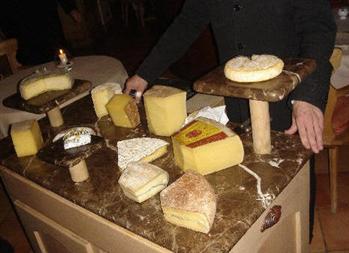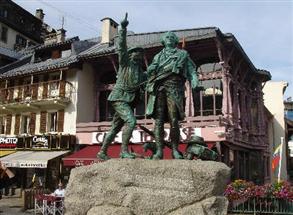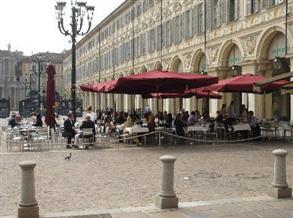We wound down the mountainside to the picturesque little town with quaint
shops and restaurants. It also contained the ubiquitous memorial to those
who did not return from World War I and a church of old, but no ancient
significance. With Marithe Crozet, director of Megeve Tourism, we had lunch
at the newly remodeled "Bistrot de Megeve" and dinner at "Fermes de Marie's"
restaurant, both great places to eat and drink. In the city of
Chamonix we checked into the "Le Hameau Albert 1er" hotel, located about a
minute from the town's centrally placed statue commemorating the first men
who climbed Mont Blanc. The "Albert 1er" is tucked in a secluded setting
with several separate lodgings. I was in a lovely room in the main building;
others were in first class rustic lodges. Dinner was at "La Maison Carrier"
where we ate another excellent meal , but fortunately for my waistline it
was not eight courses. It was served with a Quenard Pinot Noir 2006 from the
Savoie Domaine Jean-Pierre--a good local wine that went well with the Poulet
fermier roti and Les fromages de Savoie.
 Along with wine we drank in France, we tasted a number
of different cheeses out of a plethora of options. Savoie is well known for
its many cheeses but less known for its wine. The word tomme means 'cheese'
and precedes the names of many cheeses produced in the Savoie Mountain. To
name a few: Tomme de Savoie, Tomme des Bauges and Abbaye de Tamie are
semi-soft from cow's milk and Tomme de Chevres is a soft cheese from goat's
milk. There were lots of other savory choices: Roquefort was the most
famous
among the many blue-veined cheeses, and familiar names, such as, Brie,
Camembert, Gruyere, Emmentaler were generally on the cheese rack. France has
many wine producing sections--Burgundy, Bordeaux, Champagne, Provence-- but
there is only one Savoie region that produces a variety of mountain cheeses
to complement the wine.
Along with wine we drank in France, we tasted a number
of different cheeses out of a plethora of options. Savoie is well known for
its many cheeses but less known for its wine. The word tomme means 'cheese'
and precedes the names of many cheeses produced in the Savoie Mountain. To
name a few: Tomme de Savoie, Tomme des Bauges and Abbaye de Tamie are
semi-soft from cow's milk and Tomme de Chevres is a soft cheese from goat's
milk. There were lots of other savory choices: Roquefort was the most
famous
among the many blue-veined cheeses, and familiar names, such as, Brie,
Camembert, Gruyere, Emmentaler were generally on the cheese rack. France has
many wine producing sections--Burgundy, Bordeaux, Champagne, Provence-- but
there is only one Savoie region that produces a variety of mountain cheeses
to complement the wine.
The other local wines we drank in France were good, but not memorable, yet
no wine was left in the bottle. I prefer to drink the local wine, because it
is only local and not shipped out of the country. For example, two of the
Vins de Savoie we had were Domaine Edmond Jacquin
 2007 Chardonnay and a 2005
Mondeuse by Jean Cavaille. Both were light, refreshing wines. Either you
drink them here or not at all. Some are truly excellent and others merely
drinkable...none are bad.
2007 Chardonnay and a 2005
Mondeuse by Jean Cavaille. Both were light, refreshing wines. Either you
drink them here or not at all. Some are truly excellent and others merely
drinkable...none are bad.
After several epicurean days of Savoie cheese and French
wine, we left France via the Mont Blanc tunnel and headed to Torino, home
town of Fiat and host city for the 2006 Winter Olympics. This lively former
Roman city is located in the famous Piedmont district, where some of Italy's
finest wines are grown: Barolo, Barbaresco, Barbera, Moscato and Nebbiolo.
In fact, 45 Piedmont wines proudly wear the D.O.C. (Denominazione di'
Origine Controllata) crest on the label.
We stayed at the "NH Santo Safano" hotel and had splendid rooms with the
hotel well-located for sightseeing and strolling. For a change of pace a
short walk brought us to a small shop of immense popularity and renown in
the Piazza della
 Consolata. In business before Napoleon was born, "Cafe Al
Bicerin" is a charming cafe-chocolate shop not to be missed. The specialty "Bicerin"
is a hot drink made of coffee and chocolate, with milk floating on top.
Delicious! Nearby was the gigantic central Torino market area in
the Plaza Della Republica. The mostly outdoor market seemed to have an
infinite variety of foods, flowers and sundry non-edibles. We squeezed in a
visit, but it was just a side show for our group. We headed for lunch at the
world famous San Carlo Plaza where the 2006 Winter Olympics was broadcast
from and which is lined with high end stores like Armani, Hermes and Brows.
All corners of the square are populated by restaurants. We sat down for a
delightful antipasto buffet lunch at the historic Cafe San Carlo, which
offered a mouth-watering array of cold Italian specialties. This was
accompanied by a Roero Arnot Tonin, the perfect wine for a light lunch.
Consolata. In business before Napoleon was born, "Cafe Al
Bicerin" is a charming cafe-chocolate shop not to be missed. The specialty "Bicerin"
is a hot drink made of coffee and chocolate, with milk floating on top.
Delicious! Nearby was the gigantic central Torino market area in
the Plaza Della Republica. The mostly outdoor market seemed to have an
infinite variety of foods, flowers and sundry non-edibles. We squeezed in a
visit, but it was just a side show for our group. We headed for lunch at the
world famous San Carlo Plaza where the 2006 Winter Olympics was broadcast
from and which is lined with high end stores like Armani, Hermes and Brows.
All corners of the square are populated by restaurants. We sat down for a
delightful antipasto buffet lunch at the historic Cafe San Carlo, which
offered a mouth-watering array of cold Italian specialties. This was
accompanied by a Roero Arnot Tonin, the perfect wine for a light lunch.
It's difficult to believe any of the above could be topped, but we were to
visit "Eataly" the following night. We were invited to dine at "Casa Vicina"
a Michelin guidebook restaurant, which interestingly is situated in the
lower level of "Eataly," a grocery-department store. However, calling "Eataly"
a grocery store is a gross understatement. It is an eye-opener. The senses
are assaulted by pleasant smells and sights of food. The main floor is
loaded with displays of cured meats, cheeses, fruits, vegetables, fish,
coffee and baked goods. There are numerous tasting stations, a 2000 book
themed library with a cooking course room, an in-house bakery with
wood-burning oven, fresh pasta, a coffee roasting facility, and a large
countered sit-down dining-drinking area. Downstairs is a tapas bar, a
beer corner and a large wine department with perhaps 100 varieties of Barolo
alone hidden in its own corner. There
was not enough time to view the many Piedmont District wine varieties before
the call to dinner. Shielded behind all this wine was "Casa Vicina"
restaurant. Dinner did not disappoint in the gastronomic department. It was
a five-course gourmet dinner, but the menu was printed in Italian and I
distrust my translation for fear of not doing the "Menu di fine Estate"
justice. To accompany the meal we were served a prestigious full-bodied
FontanaFredda, Serra Lunga d'Alba 2004 Barolo suitably carrying the D.O.C.G.
crest.
The renown of Piedmont as a fine wine producing region
was evident in two locales we visited just to the west of Torino. The first,
"Vigneti del Ghiaccio" (ice wine vineyards) was quite remarkable in that it
only produced ice wine for three years. It was their hope that we would take
back the news that San Sebastiano 2005 ice wine is meritous of being
available in the U.S. They had already found outlets in Japan and Argentina,
but they were ambitious and wanted to move forward. At about $50 dollars the
wine is certainly worthy of being served at my table to accompany desert.
Additionally, we were privileged to taste their Ice Wine Liquor di Genepy
(74 proof) and a Liquor di Miritti (54 proof.)
 The following day we visited the "Orsolani Wine-Cellar" in the Canavesi area
of Piedmont where we were greeted by Luigi Orsolani and his son, Gian
(John.) This small vineyard has operated since 1894 despite the hardship of
WWII and has deservedly built a stellar reputation. Cheese, bread and
several types of wine were set out for our late arrival. The personable
father and son team started us off with a 2004 Cuvee Tradizione Brut
(dry) Classico Spumante, a reasonable ($20) champagnoise method wine that
goes well with drinking in the New Year. This was followed by La Rustia, a
2007 light, dry white wine from sun-ripened Erbaluce vines giving it a
non-acidic flavor. Lastly, we tasted the Orsolani Sule Caluso Passito 2003
made from overripe Erbaluce grapes that are fermented slowly and aged for
three years in oak barrels and then aged in the bottle for over a year. It
produces a slightly sweet, velvety, golden-hued dessert wine for a bargain
$30 dollars.
The following day we visited the "Orsolani Wine-Cellar" in the Canavesi area
of Piedmont where we were greeted by Luigi Orsolani and his son, Gian
(John.) This small vineyard has operated since 1894 despite the hardship of
WWII and has deservedly built a stellar reputation. Cheese, bread and
several types of wine were set out for our late arrival. The personable
father and son team started us off with a 2004 Cuvee Tradizione Brut
(dry) Classico Spumante, a reasonable ($20) champagnoise method wine that
goes well with drinking in the New Year. This was followed by La Rustia, a
2007 light, dry white wine from sun-ripened Erbaluce vines giving it a
non-acidic flavor. Lastly, we tasted the Orsolani Sule Caluso Passito 2003
made from overripe Erbaluce grapes that are fermented slowly and aged for
three years in oak barrels and then aged in the bottle for over a year. It
produces a slightly sweet, velvety, golden-hued dessert wine for a bargain
$30 dollars.
Later that night we strolled down the Via Po, a wonderfully portico-lined
street of popular shops and restaurants. Our dinner was at the "in" Porta de
Po in the very nightlife-active Piazza Vittoro Veneto that attracts young
revelers out for a
fun time of food, drink and camaraderie. The service was a turn-off preceded
by a ho-hum dinner accompanied by an unimpressive Roero Arneis Controlle E.
Garantita 2007 Cornarea white chardonnay that was cloyingly sweet. This was
accompanied by a Fratelli Alessandria that was a light bodied red of fair
quality. Perhaps it was me after a week of wonderful food and wine,
yet sometimes an
"in" place has read its own reviews and can no longer live up to
expectations. Regions like Piedmont and Savoie are wonderful areas to
visit. They contain a no-vehicle-permitted village like Megeve, Chamonix's
historic center and large Romanesque cities like Torino that are active with
people of all ages that enhance the travel experience. All the above are
within two hours of each other which makes a daytime excursion easily
possible.
Postscript. After returning to the U.S. I tried to find the Chateau Clarke
locally with no success. It may be available in other major wine
distribution regions such as, New York City. However, I did find a sister
wine, Chat Malmaison 2003 "Baronne" Nadine de Rothschild from the Listract
property adjoining Chateau Clarke. Its soft tasting wine goes well with
lamb, fowl or game dishes, but I preferred it with cheese. Of course!
Contacts:
www.hameaualbert.fr
www.chalet-montarbois.com
www.eatalytorino.it/ or
www.eataly.it/
www.nh-hotels.com
www.orsolani.it